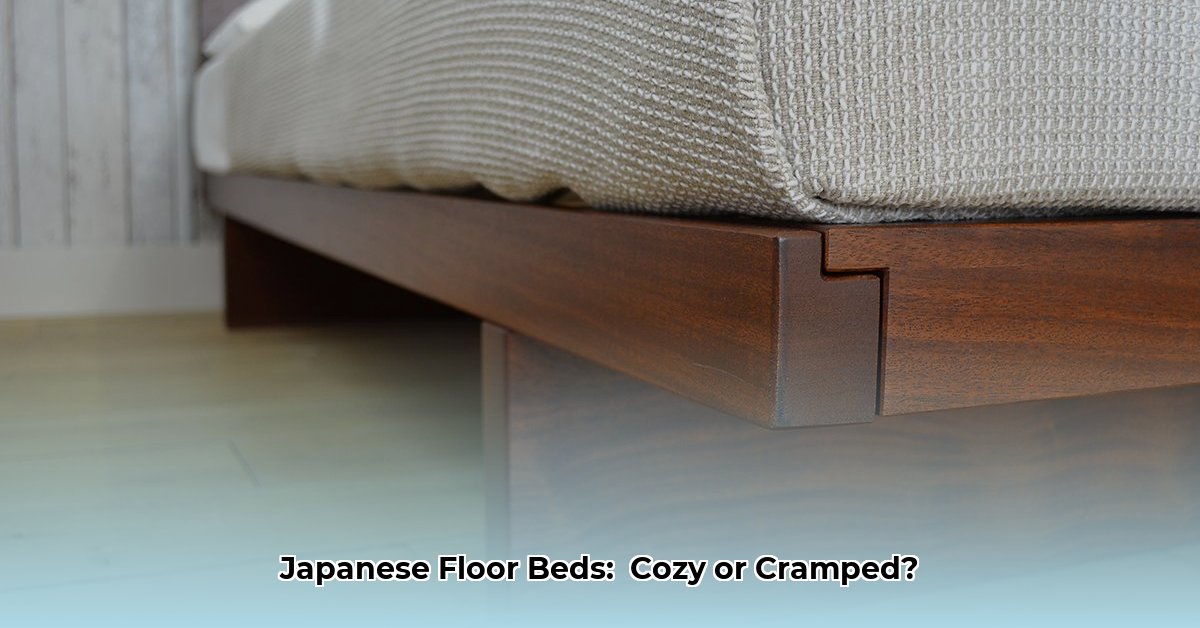Imagine stepping into a serene, minimalist bedroom, uncluttered and calming. At its center, a traditional Japanese futon rests upon woven tatami mats, inviting you to experience a sleep unlike any other. This guide explores the world of Japanese floor beds, from their cultural significance to practical tips for incorporating them into your modern life.
The Allure of the Shikibuton
Sleeping on a Japanese floor bed, or shikibuton, is a centuries-old tradition deeply embedded in Japanese culture. More than just a mattress, the shikibuton represents a connection to a simpler, more mindful way of living. It’s a portable, comfortable mattress, traditionally filled with natural materials like cotton or wool. Paired with the tatami mat, it creates a sleep system that promotes tranquility and rest.
The Tatami: More Than Just Flooring
Woven from igusa straw, tatami mats provide natural insulation, gentle cushioning, and a subtle fragrance. They serve as a supportive yet yielding base for the shikibuton, absorbing impact and creating a serene sleeping environment. Their natural properties may also contribute to a cooler sleep surface.
Why Choose a Japanese Floor Bed?
The enduring popularity of the shikibuton suggests a continued appreciation for its blend of comfort, practicality, and cultural connection. But is it right for you? Let’s explore the potential benefits and drawbacks.
Potential Advantages
- Space-Saving: Ideal for smaller living spaces, the shikibuton can be easily folded and stored away during the day.
- Portability: Easy to move and transport, making it a great option for those who move frequently or enjoy camping.
- Potential Health Benefits: Some proponents suggest that sleeping on a firmer surface like a shikibuton may improve spinal alignment and alleviate back pain. Further research is needed to confirm these claims.
- Cooler Sleep: The breathable materials and design of the shikibuton can promote better airflow, leading to a cooler sleep experience.
- Minimalist Aesthetic: The shikibuton contributes to a clean, uncluttered aesthetic, fostering a peaceful bedroom environment.
- Connection to Tradition: Embracing the shikibuton can be a way to connect with Japanese culture and a more minimalist lifestyle.
Potential Drawbacks
- Daily Setup and Storage: Requires daily effort to set up and put away.
- Firmness: The firmness may not be suitable for everyone, particularly those accustomed to softer mattresses.
- Accessibility: Getting on and off the floor may be difficult for people with mobility issues.
- Maintenance: Requires regular airing and cleaning to prevent dust mites and mold.
Setting Up Your Japanese Floor Bed: A Step-by-Step Guide
Creating your Japanese floor bed is a simple process. Here’s how to get started:
- Prepare the Floor: Clear the area and lay down your tatami mat or chosen base layer (rug, mattress topper).
- Place the Shikibuton: Unfold the shikibuton on top of the base layer.
- Add Bedding: Cover the shikibuton with a fitted sheet, followed by a flat sheet.
- Arrange the Kakebuton (Comforter): Drape the kakebuton over the shikibuton. A duvet cover or fitted sheet can further protect the kakebuton.
- Position the Makura (Pillow): Place your makura at the head of the bed.
- Consider Optional Extras: A tatami mattress pad can provide additional comfort and insulation if you aren’t using a tatami mat underneath.
Caring for Your Shikibuton and Tatami
Maintaining your shikibuton and tatami involves a few simple practices:
Shikibuton Care
- Airing: Air your shikibuton regularly, preferably in direct sunlight, for at least two hours on each side to prevent dust mites and freshen the filling.
- Cleaning: Spot clean as needed. Use breathable cotton sheets and wash them weekly. Store in a dry, well-ventilated area when not in use.
Tatami Care
- Cleaning: Vacuum regularly along the grain of the weave. Sprinkling dry, used tea leaves before sweeping can help collect dust.
- Spot Cleaning: Wipe spills immediately with a damp cloth.
- Deep Cleaning: Occasionally wipe with a mild detergent solution followed by rubbing alcohol.
- Airing and Sun-Drying: Air out regularly and sun-dry twice a year to prevent mold and mildew.
Choosing the Right Components
Selecting the right components involves considering your personal preferences and needs. Here’s a quick overview:
| Component | Considerations | Price Range |
|---|---|---|
| Shikibuton | Filling (cotton, wool, synthetics), firmness, thickness | $50 – $500+ |
| Kakebuton | Filling (cotton, silk, down, synthetics), weight, warmth | $30 – $300+ |
| Makura | Filling (buckwheat hulls, beans, cotton), firmness | $15 – $100+ |
| Tatami Mat | Size, quality | $50 – $300+ per mat |
| Tatami Mattress Pad | Thickness, material | Varies |
Research different options, read reviews, and if possible, try out different shikibutons and pillows before purchasing.
The Evolving Landscape of Sleep in Japan
While Western-style beds are becoming increasingly common in Japan, the shikibuton remains a beloved symbol of tradition and minimalist living. Whether you seek a more minimalist lifestyle, a connection to Japanese culture, or simply a unique sleep experience, the shikibuton offers a refreshing alternative to conventional bedding. By understanding its history, benefits, and care requirements, you can make an informed decision about whether a Japanese floor bed is the right choice for you.
- How to Get a Free Mold Inspection (and Avoid the Scams) - April 23, 2025
- How to Flush a Toilet Without Water: A Step-by-Step Guide - April 23, 2025
- The Complete Guide to Safely Disposing of Light Globes - April 23, 2025










